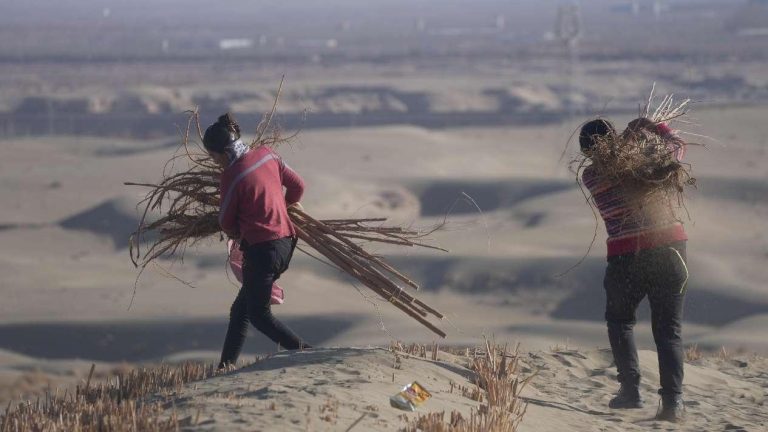
By He Yin, The largest desert in China, the Taklimakan has been completely encircled by a green belt stretching 3,046 km as of late November, thanks to more than four decades of efforts as part of China’s Three-North Shelterbelt Forest Program (TSFP), the world’s largest afforestation program to tackle desertification.
This great achievement has captured worldwide attention. The international community observes that the TSFP has not only contributed to the global combat against desertification, but also increased the global forest coverage rate. They praised the program as the “green Great Wall” that China fortifies to fend off the challenges arising from climate change.
The Taklimakan Desert is China’s largest and the world’s second-largest drifting desert. The completion of the ecological barrier vividly demonstrates China’s battle against desertification.
After over 40 years of unremitting efforts, China has blazed a special path of desertification prevention and control with Chinese characteristics. Environmental conservation and improving people’s well-being have entered a virtuous cycle. The country has become a global model for desertification control.
So far, China has effectively rehabilitated 53 percent of its treatable desertified land, with the area of desertified land decreasing by 65 million mu (about 4.3 million hectares). It is the first country in the world to achieve zero growth in land degradation, and the first to reduce the area of desertified and sandy land.
To be specific, Saihanba in north China’s Hebei province has transformed from a desolate land into the world’s largest man-made forest, thanks to the dedication of three generations of foresters to the Saihanba afforestation project; most of the sand land in the Mu Us Desert, which stretches from north China’s Inner Mongolia autonomous region to Shaanxi province, has been brought under control; the Kubuqi Desert, China’s seventh-largest desert, has explored a brand new approach to combating desertification through industrial development.
The United Nations Convention to Combat Desertification (UNCCD) Secretariat has twice honored China for its “outstanding contribution to combating desertification”, praising its significant contributions to global desertification control.
The 16th Conference of the Parties (COP16) to the UNCCD held in Riyadh, capital of Saudi Arabia, set up the China Pavilion, which marked the first time that China showcased its achievements in desertification control, particularly through the TSFP.
“I was moved by the images of different generations of Chinese people fighting desertification and by China’s leadership in this process,” said Andrea Meza Murillo, UNCCD deputy executive secretary.
She emphasized that effective policies, community and local government involvement, as well as innovation and technology, are key components of China’s success.
The achievements in desertification control reflect China’s relentless efforts to advance ecological conservation. Since the 18th National Congress of the Communist Party of China, the country has ensured stronger ecological conservation and environmental protection across the board, in all regions, and at all times.
China has achieved a significant transformation from remediation of major areas to systematic governance; realized an important shift from passively responding to ecological issues to taking proactive actions to address them; has become a leader from a participant in global environmental governance; and has realized a major shift from practical-exploration-based conservation to the one with theoretical guidance.
China’s forest coverage ratio and forest stock volume have both been on the rise for 40 consecutive years. The country ranks first in the world in terms of forest resource growth and afforestation area. It has contributed to one forth of the world’s newly added green areas.
China is also contributing to the global fight against desertification with firm and concrete actions.
This year marks the 30th anniversary of China’s adoption of the UNCCD. Over the past three decades, China has been actively involved in global desertification governance within the framework of UNCCD.
It promoted the establishment of the Committee for the Review of the Implementation of the Convention (CRIC), setting up the strategic framework and objectives; established an office for UNCCD implementation and formulated a national action plan; and set up regional mechanisms to promote regional cooperation on UNCCD fulfillment.
Besides, China hosted the COP 13 to the UNCCD and carried out cooperation on desertification control within the framework of the Belt and Road Initiative (BRI). It has held nine sessions of the Kubuqi International Desert Forum to promote international policy dialogue and exchanges.
China is also actively sharing its technologies and experiences of desertification control with other developing countries, pursuing green development together with the Global South.
It has established an international training center and an international knowledge management center on combating desertification together with the UNCCD Secretariat. Besides, the country trains nearly 100 professionals in this field each year for developing countries in Africa, Asia and Latin America, by hosting international seminars and setting up demonstration bases for desertification control.
It has taken the initiative to align with the Great Green Wall initiative launched by the African Union and the Saudi Arabia-led Middle East Green Initiative, within the frameworks of the Forum on China-Africa Cooperation (FOCAC) and the China-Arab States Cooperation Forum (CASCF). It has also established the China-Arab International Research Center on Drought, Desertification, and Land Degradation.
The prevention and control of desertification is a great cause bearing on the sustainable development of all humanity. China will keep acting as a participant and leader in global desertification control, and work with all parties to advance ecological conservation and promote sustainable development for a clean and beautiful world.










